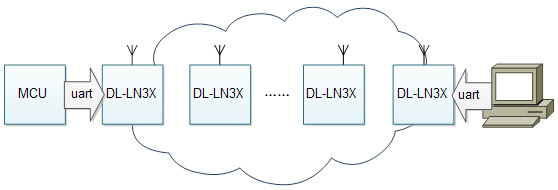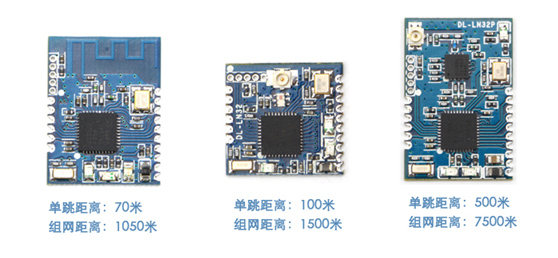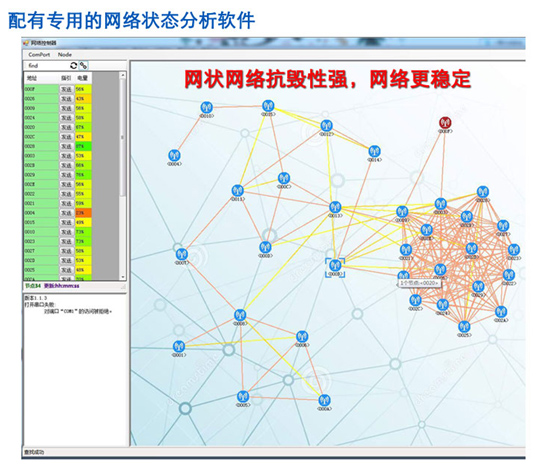DL-LN Series Multi-hop Ad Hoc Network Modules Now Available, Significantly Reduced Product Development Cycles Compared to Zigbee
The development of multi-hop ad hoc network technology Since 2000, with the continuous maturation of wireless transmission technologies, wireless personal area networks, wireless sensor networks, and wireless ad hoc networks have emerged in turn. In 2002, the IEEE 802.15 working group was established. IEEE 802.15.4 is the standard for low-speed wireless personal area networks. Two years later, the zigbee V1.0 standard was introduced. The zigbeePRO version was introduced in 2007. Zigbee is a wireless personal area network solution based on IEEE802.15.4. Since 2009, with the promotion of IPV6 research 6LoWPAN technology has begun to flourish, becoming a popular solution for wireless network technology.
Although after more than ten years of development, the application and promotion of wireless self-organizing network technology has not been smooth. There are few mature products using ad hoc network multi-hop technology in the market. Zigbee, 6LoWPAN and other wireless ad hoc network technologies use wireless chips + open source programs to construct solutions, such as the CC2530+Zstack program introduced by TI. Using such a solution, developers need to be familiar with the zigbee protocol and master the Zstack program and perform modify. It is usually required to use Zstack for six months to one year for development. Because the user program and the protocol stack program are compiled together, if the program encounters a bug, it is very difficult for developers to locate the bug. These problems are the reasons for restricting the promotion of open source solutions.
Relatively speaking, using wireless modules for development is more convenient. With the development of integrated circuit technology, the size of wireless transceivers continues to shrink. Around 2000, wireless modules that can transmit level signals appeared on the market. Since 2005, these modules have been gradually promoted and launched in the market. , lighting, billboards, car remote control doors and remote control gates and other occasions are widely used. With the development of technology, there are wireless modules that can transmit data on the market. These modules can send and receive data through the serial port for point-to-point communication or simple network communication. The wireless module is simple to develop and can operate through the serial port, but most of the current wireless modules cannot perform multi-hop transmission, or have poor stability in multi-hop transmission.
Design Intent of Multi-hop Modules for DL-LN Series Ad Hoc Networks
The DL-LN series modules can automatically form self-organized multi-hop networks. Under the premise of ensuring stability, the modules reduce the development difficulty through functional packages, thereby shortening the development cycle.


DL-LN series modules combine the advantages of wireless modules and wireless protocol stacks. This module is designed for multi-hop ad hoc networks and can form multi-hop mash networks. After networking, each node in the network can be connected to the network. Any other node in the communication, if the target node is not within the communication range, the communication will be forwarded by other nodes in the network to complete, namely multi-hop communication. The DL-LN series modules are optimized for multi-hop networks in design, simulation, and experimentation and can support up to 16-hop transmissions.
Using DL-LN series modules is much simpler than open source programs. Users only need to learn the module's serial port protocol to communicate with the operating ad hoc networks and communicate with all other modules in the network. Because the user program is simple, troubleshooting is also very easy. DL-LN series modules can help users to master ad hoc network communication technology in less than 1 month, thereby shortening the product development cycle.
Module stability optimization design
In the design process, the DL-LN module has abandoned relatively complex protocols and technologies and designed it with simple but stable technology to ensure stable network operation.
At the operating system level, the DL-LN module uses an operating system similar to Tinyos. It uses event publishing instead of multitasking polling, and does not require timers to help switch threads. Such operating system is closer to no operating system than ucOsII, because this operating system is more efficient and stable.
For wireless modules that frequently send and receive packets, dynamic memory allocation is very important. However, the dynamic memory allocation using the heap is not stable during long-term operation, and is prone to memory fragmentation and takes a long time. The DL-LN module uses a memory pool for dynamic memory allocation. This memory allocation strategy does not generate memory fragmentation, so that the system can work stably for a long time.
The DL-LN module uses the CC2530 as a wireless chip, which has a high market share and stable operation.
Wireless communication uses an automatic retransmission mechanism with cyclic redundancy check. After packet loss occurs in the communication process, the module will immediately retransmit the packet to ensure stable communication.
Simplify development and optimization
The operation method of the DL-LN module is very simple and easy to use. The module is equipped with a development evaluation board with network sniffing analysis software.

Network-oriented communication uses a directed proliferation protocol. Each node has equal network status. Coordinators, routers, and other devices do not exist on the network. Therefore, any device damage does not affect the functions of the entire network. At the same time, after the node is damaged, the user only needs to replace the hardware and does not need to configure the node identity, so the product maintenance is very simple.
Follow-up design is in progress
The DL-LN module is now available, and its follow-up product updates are still in progress, including hibernation, time synchronization, RSSI testing, and other update functions.
The development of multi-hop ad hoc network technology Since 2000, with the continuous maturation of wireless transmission technologies, wireless personal area networks, wireless sensor networks, and wireless ad hoc networks have emerged in turn. In 2002, the IEEE 802.15 working group was established. IEEE 802.15.4 is the standard for low-speed wireless personal area networks. Two years later, the zigbee V1.0 standard was introduced. The zigbeePRO version was introduced in 2007. Zigbee is a wireless personal area network solution based on IEEE802.15.4. Since 2009, with the promotion of IPV6 research 6LoWPAN technology has begun to flourish, becoming a popular solution for wireless network technology.
Although after more than ten years of development, the application and promotion of wireless self-organizing network technology has not been smooth. There are few mature products using ad hoc network multi-hop technology in the market. Zigbee, 6LoWPAN and other wireless ad hoc network technologies use wireless chips + open source programs to construct solutions, such as the CC2530+Zstack program introduced by TI. Using such a solution, developers need to be familiar with the zigbee protocol and master the Zstack program and perform modify. It is usually required to use Zstack for six months to one year for development. Because the user program and the protocol stack program are compiled together, if the program encounters a bug, it is very difficult for developers to locate the bug. These problems are the reasons for restricting the promotion of open source solutions.
Relatively speaking, using wireless modules for development is more convenient. With the development of integrated circuit technology, the size of wireless transceivers continues to shrink. Around 2000, wireless modules that can transmit level signals appeared on the market. Since 2005, these modules have been gradually promoted and launched in the market. , lighting, billboards, car remote control doors and remote control gates and other occasions are widely used. With the development of technology, there are wireless modules that can transmit data on the market. These modules can send and receive data through the serial port for point-to-point communication or simple network communication. The wireless module is simple to develop and can operate through the serial port, but most of the current wireless modules cannot perform multi-hop transmission, or have poor stability in multi-hop transmission.
Design Intent of Multi-hop Modules for DL-LN Series Ad Hoc Networks
The DL-LN series modules can automatically form self-organized multi-hop networks. Under the premise of ensuring stability, the modules reduce the development difficulty through functional packages, thereby shortening the development cycle.


DL-LN series modules combine the advantages of wireless modules and wireless protocol stacks. This module is designed for multi-hop ad hoc networks and can form multi-hop mash networks. After networking, each node in the network can be connected to the network. Any other node in the communication, if the target node is not within the communication range, the communication will be forwarded by other nodes in the network to complete, namely multi-hop communication. The DL-LN series modules are optimized for multi-hop networks in design, simulation, and experimentation and can support up to 16-hop transmissions.
Using DL-LN series modules is much simpler than open source programs. Users only need to learn the module's serial port protocol to communicate with the operating ad hoc networks and communicate with all other modules in the network. Because the user program is simple, troubleshooting is also very easy. DL-LN series modules can help users to master ad hoc network communication technology in less than 1 month, thereby shortening the product development cycle.
Module stability optimization design
In the design process, the DL-LN module has abandoned relatively complex protocols and technologies and designed it with simple but stable technology to ensure stable network operation.
At the operating system level, the DL-LN module uses an operating system similar to Tinyos. It uses event publishing instead of multitasking polling, and does not require timers to help switch threads. Such operating system is closer to no operating system than ucOsII, because this operating system is more efficient and stable.
For wireless modules that frequently send and receive packets, dynamic memory allocation is very important. However, the dynamic memory allocation using the heap is not stable during long-term operation, and is prone to memory fragmentation and takes a long time. The DL-LN module uses a memory pool for dynamic memory allocation. This memory allocation strategy does not generate memory fragmentation, so that the system can work stably for a long time.
The DL-LN module uses the CC2530 as a wireless chip, which has a high market share and stable operation.
Wireless communication uses an automatic retransmission mechanism with cyclic redundancy check. After packet loss occurs in the communication process, the module will immediately retransmit the packet to ensure stable communication.
Simplify development and optimization
The operation method of the DL-LN module is very simple and easy to use. The module is equipped with a development evaluation board with network sniffing analysis software.

Network-oriented communication uses a directed proliferation protocol. Each node has equal network status. Coordinators, routers, and other devices do not exist on the network. Therefore, any device damage does not affect the functions of the entire network. At the same time, after the node is damaged, the user only needs to replace the hardware and does not need to configure the node identity, so the product maintenance is very simple.
Follow-up design is in progress
The DL-LN module is now available, and its follow-up product updates are still in progress, including hibernation, time synchronization, RSSI testing, and other update functions.
Circular Saw Machine,Cnc Sharpening Machine,Circular Saw Blade Sharpener,Sharpening Machine
WEISS MACHINERY CO., LTD. , https://www.weissmachinery.com